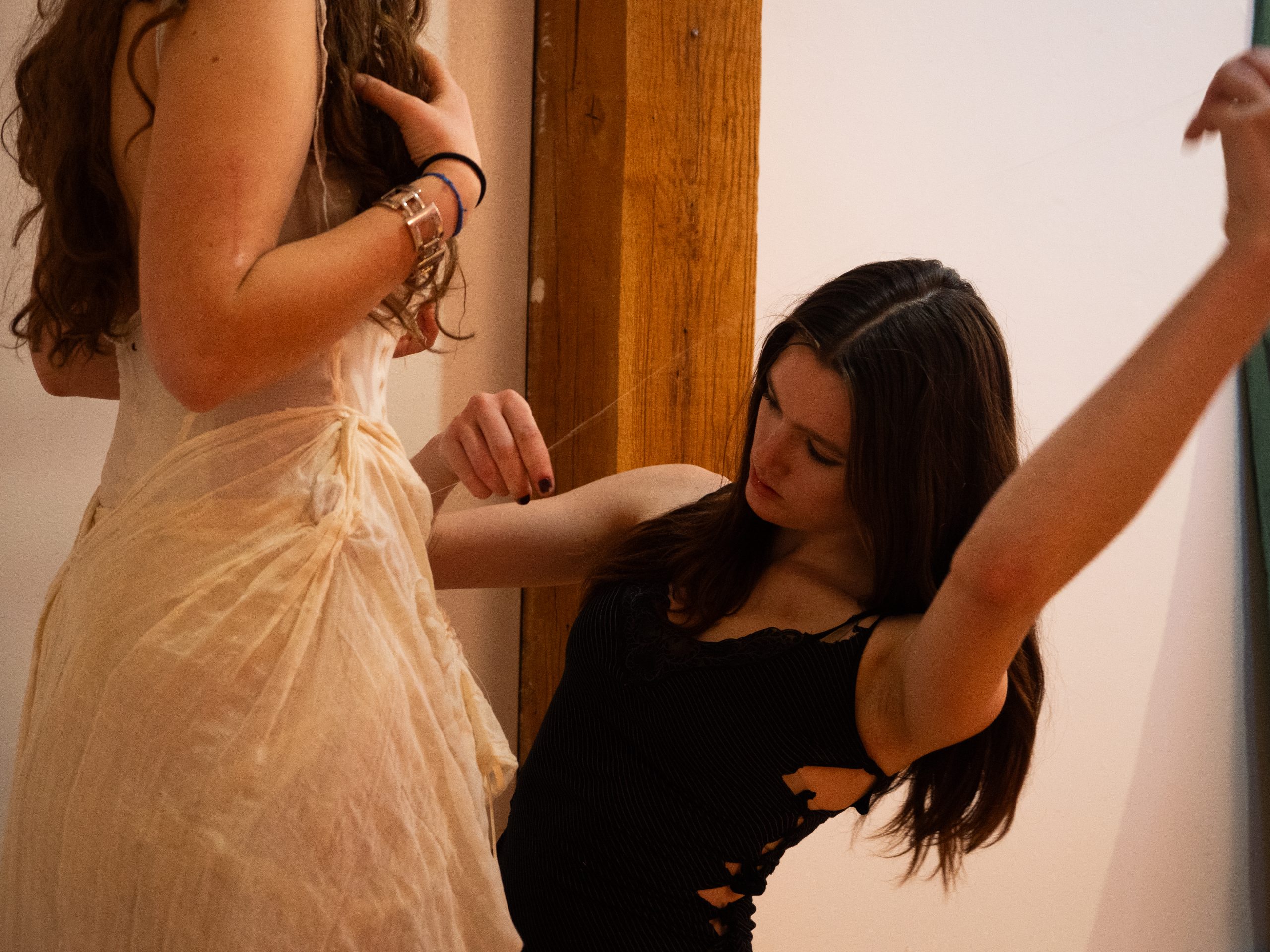
A model and stylist preparing for WEARHAUS, Kenyon’s first fashion show. | BRITTANY LIN
A walk around campus will reveal one fact: Kenyon students are a stylistic bunch. The fashion show WEARHAUS at the Horn Gallery last Friday took it to another level.
“I wanted to create a space for fashion to happen on this campus because there isn’t really a space for people to make clothes or style a model and express themselves in that way,” Sam Ehrlich ’24, the organizer of the show, said. His passion for fashion was first ignited in high school through skate culture, and he has ardently pursued it ever since, having worked for Ralph Lauren’s Polo Men’s Concept Design Team and studied abroad in Milan, the menswear capital of the world.
The WEARHAUS team aimed to immerse the audience in a grungy underground atmosphere, and the creatives behind the show were given ample freedom to style the outfits to their own idiosyncratic vision. WEARHAUS showcased over 20 looks, all designed and styled by Kenyon students. Some of the designers and stylists modeled their own looks.
“I didn’t want there to be a special theme that everyone had to do, which turned out great I think, because people have all types of different aesthetics,” Ehrlich said. “It’s not just this kind of dark underground style; there’s really fun stuff as well. So I wanted to keep it open and just give the space for the designers.”
Attendees gathered on both levels of the Horn, cordoned off from the runway that occupied the perimeter of the room. The space buzzed with anticipation and pulsating music from the DJ table in the Upper Horn, made all the more rhythmic by an accompanying drum set in the Lower Horn. The crowd erupted into cheers as the first model strutted in, wearing a wire frame for a top, a transparent vinyl skirt over jeans and flaming-red chunky sneakers.
The models walked a two-level runway: they began in the Lower Horn, ascended to Upper Horn, made their way around the audience and then headed back downstairs. The WEARHAUS repertoire was playful and mercurial, offering an elevated spin on current fashion trends: pink bow ties, a nod to the recent coquette frenzy. Vibrant lace top with earth-tone dress. Twirly ruffle rainbow skirt. Russian Ushanka hat. Pink balaclava.
Oftentimes, the looks aimed to subvert expectations of material and silhouette. For example, Ehrlich designed a football-inspired look with a jersey top made from the unlikely material of denim and a skirt made from jersey fabric.
Other looks played on gender expectations. “I wanted to play the levels of girlhood to womanhood, so we thought of bows, hair clips, leg warmers and very cute colors like pink,” stylist Nicole Wang ’26 said. “There’s a taking back of a femininity and a style that makes you feel connected to your childhood self.” These girlish elements were fused with sleek, more professional-looking white and black attire “We’re playing with a lot of masculine shapes,” Wang continued. “There’s this edge: We have very sharp lines and really big heavy shoes. Like we are taking up space.” The styling process was not only a reclamation of femininity for Wang, but also one of culture. As many items in her looks are bought from her trip to China, she detailed a limbo: In the US, clothing styles from China are often overlooked, and in China, the constricting beauty standard has limited her choice of garments. “Bringing that [issue] into the Western perspective is really interesting,” Wang said.
After the runway portion of the show ended, the gallery devolved into a lively afterparty featuring DJ sets from five Kenyon students. While some attendees showed up in everyday clothes, others brought their runway-worthy looks to the show. Tutus spun, fluorescent jackets flashed and fur coats fluttered as their wearers hopped and swayed.
For people who missed the show but are intrigued by this special moment in the history of Kenyon’s fashion community, the WEARHAUS team will release an online publication, led by Andres Castillo ’24, by the end of this semester. The publication will consist of the editorial photoshoots taken before the show and the runway looks captured during its duration.
When asked what he wants the audience to take away from WEARHAUS, Ehrlich said, “I hope that people will walk away feeling that Kenyon can be a place for forward-thinking individuals to express themselves.” The show achieved just that.
Arts editor Dorothy Yaqub ’26 was a model in WEARHAUS.
